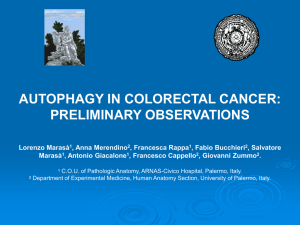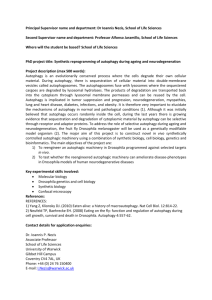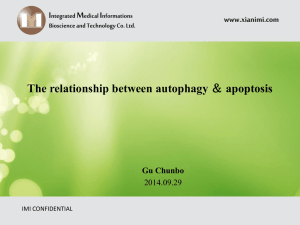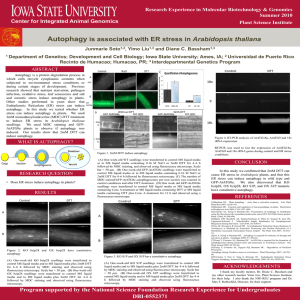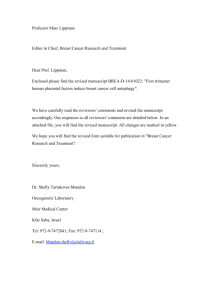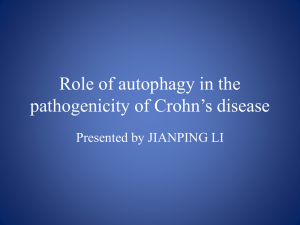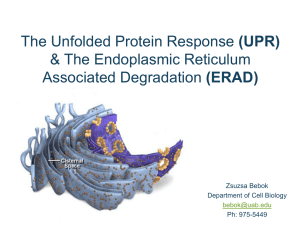Introduction to DMVs
advertisement
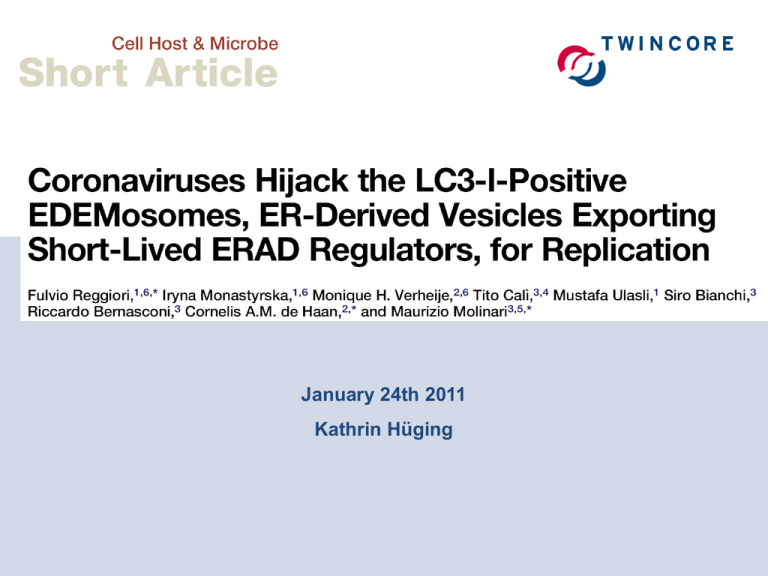
January 24th 2011 Kathrin Hüging Introduction to Coronaviruses • Coronaviruses: Coronaviridae family, order Nidovirales • Gained prominence during the SARS (severe acute respiratory syndrome) outbreak in 2002 – 2003 • Prototypical coronavirus: Mouse Hepatitis Virus (MHV) • Enveloped viruses with positive single stranded RNA genome • • • • S= Spike M= Membrane E= Envelope N= Nucleocapsid (Perlman & Netland, Nature Reviews Microbiology, 2009) Introduction to DMVs (Perlman & Netland, Nature Reviews Microbiology, 2009) • Early upon infection, coronaviruses induce the formation of double-membrane vesicles (DMV) in host cells • Replication and transcription complexes (RTC) are targeted to DMVs ( site of replication) • DMVs are derived from the endoplasmic reticulum (ER) • But: DMV biogenesis seems not to depend on conventional routing of proteins through this transport pathway: • no ER protein markers • No markers of ER-Golgi intermediate compartment • No Golgi protein markers • Conflicting data regarding the role of autophagy in CoV replication Aim of the study: Open questions: • What is the precise origin of DMV lipid bilayers? • What is the host protein content? • What cellular factors are essential for DMV formation? • Is autophagy involved? AIM To unveil the origin of virus-induced double membrane vesicles (DMVs) and to indentify host cell factors essential for CoV replication MHV infection does not require an intact autophagy machinery • mouse embrionic fibroblasts (MEF) from wildtype and Atg7 knockout mice were infected with MHV and further analyzed: Atg7: essential for autophagy Nsp2/3: viral non-structural proteins, are components of RTC (replication and transcription complexes) Puncta represent virus-induced DMVs that contain viral dsRNA no differences in DMV morphology between wildtype and Atg7 knockout mice MHV infection does not require an intact autophagy machinery Infection of MEFs with MHV reporter virus: no differences in virus entry and replication of the viral RNA Titraton of MHV virus stock on MEFs: no differences in production of viral progeny autophagy is not required for viral replication and production of viral progeny Nonlipidated LC3/ATG8 associates with CoV-induced DMVs • LC3/ATG8: • • autophagosome protein marker (GFP-LC3 commonly used) contradictory data available regarding its presence on DMVs Analysis of LC3 in HEK293 cells: endogenous LC3 colocalizes with DMV protein markers ectopically GFP-LC3 does not colocalize Nonlipidated LC3/ATG8 associates with CoV-induced DMVs • • • upon autophagy induction, cytoplasmic form LC3-I is converted into an active lipidated form LC3-II LC3-II coats autophagosomes both the lipidation and the formation of LC3-II coated autophagosomes depends on several proteins, including Atg7 Infection of wt and Atg7 ko MEFs with MHV: Analysis of LC3 lipidation in HeLa cells: colocalization of LC3 with DMVs does not depend on presence of Atg7 lipidation of LC3-I not required for colocalization to DMVs LC3 is required for MHV and for formation of DMV siRNA against LC3 reduces expression of nucleocapsid protein and viral RNA replication: ectopic expression of non-lipidable LC3 rescues phenotype siRNA against LC3 inhibits formation of DMVs BUT: if viral RNA is not replicated, no/low protein expression no DMV marker available! (EM pictures needed to confirm IF data) Analogies between MHV-induced DMVs and EDEMosomes • MHV induced DMVs: • ER origin • no conventional ER markers • are associated with LC3-I but not with GFP-LC3-I share similarities with EDEMosomes What are EDEMosomes? • • • • • newly synthesized polypeptides in the ER can either attract folding machinery or degradation machinery (ERAD machinery, ER-associated degradation) normal growth conditions: • activity of ERAD machinery is maintained at a low level (avoid premature interruption of folding programs) ERAD-tuning: clearance of ERAD regulators by selective sorting of ERAD regulators (e.g. EDEM1 or OS-9) into EDEMosomes EDEMosomes are small vesicles that emerge from the ER in a COPII independent mechanism and deliver their content to endosomal compartments poorly characterized: role of autophagy? Influence of active and inactive autophagy on components of the ERAD tuning pathway • comparison of intracellular levels of EDEM1 (ERAD regulator) and p62 (canonical substrate of autophagy) under active or inactive autophagy Inactive autophagy: Atg7 ko mice Westernblot analysis of MEFs: EDEM1 levels are not affected p62 levels are increased in the Atg7 ko mice • deletion of Atg7 was published to inhibit p62 turnover Pulse-chase radiolabeling of MEFs: similar rates of disposal of EDEM1 in presence and absence of ATG7 EDEM1 level is not affected (Atg7 and conventional autophagy are dispensible for EDEM1 turnover) Influence of active and inactive autophagy on components of the ERAD tuning pathway • comparison of intracellular levels of EDEM1 (ERAD regulator) and p62 (canonical substrate of autophagy) under active or inactive autophagy Inactive autophagy: chloroquine (CQ) treatment Active autophagy: rapamycine (rap) treatment Westernblot analysis of wt MEFs: CQ inhibits p62 degradation and delayed EDEM1 turnover EDEM1 accumulation rap reduced intracellular p62 levels but increased EDEM1 by delaying its turnover Pulse-chase radiolabeling of wt MEFs: EDEM1 turnover is decreased after treatment with CQ or rap the pathway regulating EDEM1 turnover is distinct from autophagy (because both activation and inactivation of autophagy seem to have an influence?) Components of the ERAD tuning pathway are associated with DMVS • Hypothesis: • MHV hijacks the ERAD tuning machinery to co-opt cellular membranes for DMV generation Infection of HeLa cells with MHV: EDEM1 and Os-9 (ERAD regulators) localize to DMVs MHV infection leads to a defective clearance of EDEM1 and OS-9 However, EDEM1 and OS-9 are not required for MHV infectivity (supplement figure) summary • CoV hijack the ERAD tuning machinery for the generation of DMVs, which provide the membranous support for viral RTCs • By this, MHV interferes with the degradation of EDEM1 and OS-9 by trapping them in DMVs data are consistent with the model in which DMVS are generated from the host ER • Explain the absence of conventional ER resident chaperones in DMVs • LC3 is required for DMV formation, even though the conventional autophagy pathway is not essential (Atg7 ko has no influence) BUT: Atg5/7-independent type of autophagy, does also not involve lipidation of LC3-II (Nishida et al., 2009)
